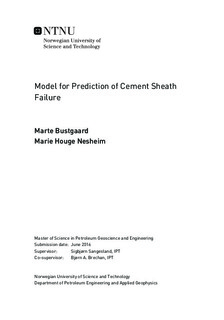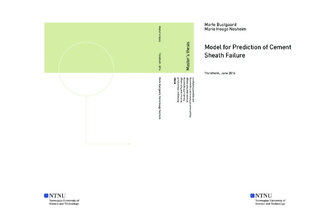| dc.description.abstract | In casing design, the casing is required to withstand all loads it is exposed to during the well life. These loads are normally modeled in an industry leading software (ILS), which determines whether the casing can withstand the loads. The well cement is also subjected to the operational loads. However, the cement strength is not included in the ILS. Other complementary softwares are available, but are not always included as standard practice.
In this thesis, a cement sheath mechanical model has been developed in order to investigate the necessity of considering the cement. Safety factors (SF) for the cement resulting from the model, and for the casing resulting from the ILS have been compared. This is done in order to determine if the cement fails before the casing fails in some scenarios. Through this comparison, the necessity of an additional feature in the ILS have been determined.
The model have been developed by the use of axisymmetric thick-walled cylinder theory, considering three cylinders; one for the casing, one for the cement and one for the formation. By considering this theory, the stresses through a cross-section of the cylinders have been calculated, and further, failure criteria have been applied to the stresses. Three failure modes have been considered; debonding of the cement at the casing and formation interfaces, radial cracks and shear failure in the bulk cement. In order to thoroughly investigate how the cement SFs change with variable cement mechanical properties, sensitivity analyses have been performed at various pressure and temperature changes. For one load case, the worst- and the best-case combinations of mechanical properties for each failure mode have been identified, and included in the comparison with the ILS. This has been done to achieve a broad knowledge, and to more effectively conclude whether complementing the ILS is necessary.
The results indicated that debonding was likely at well pressure decreases, while radial cracks mostly occurred at pressure increases. Shear failure occurred at both large pressure increases and pressure decreases. When the worst-case burst and collapse loads, for typical casing and cement properties, were considered, the cement failed in tension before the casing failed. However, the results were less prominent when the worst- and best-case of mechanical properties of the cement and formation were considered. The cement was mostly exposed to lose its integrity through debonding, due to several combinations of mechanical properties resulting in debonding for a worst-case collapse load. It was therefore concluded that it could be beneficial to include an additional feature to the ILS, which analyzes the cement integrity when performing casing design. | |

